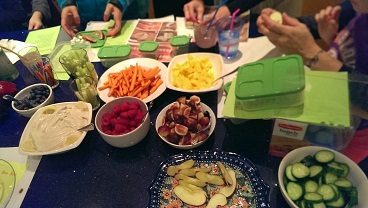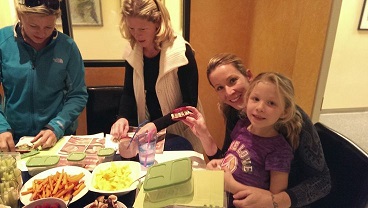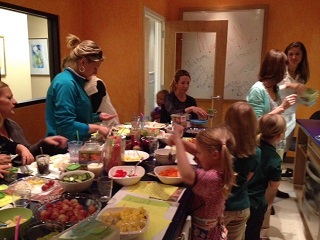In 2012, we accomplished a critical step on the road to deliver healthier food to our nation’s school children when the U.S. Department of Agriculture released new rules that will boost the nutritional quality of the meals eaten by school children every day. The rules represent the first major revision of school meal standards in more than 15 years and make sure our kids’ lunches and breakfasts will have more whole grains, vegetables and fruits, and less fat and sodium in conjunction with sensible calorie limits based on the age of children being served. Based on recommendations from the Institute of Medicine, the new school meals include these changes:
-
More whole grains, fruits and vegetables, low-fat milk dairy products and less sodium and fat.
-
The right portion. Menus are planned for grades K-5, 6-8 and 9-12 and will demonstrate to your child the right size portions.
-
Additional funding will be made available to schools that meet the new standards. Schools will be reimbursed an additional 6 cents for each lunch they serve in accordance with the new standards.
 As a child, my mom packed all of my school lunches. She was frustrated with the school’s cafeteria food. It was all unhealthy, full of refined sugars and processed pizza, chicken nuggets, hamburgers, etc. I would get teased from the kids at school for my healthy, boring packed lunches. I absolutely hated the teasing. But today when I think back to what my mom took the time to do, I am thankful for her attitude about healthy food.
As a child, my mom packed all of my school lunches. She was frustrated with the school’s cafeteria food. It was all unhealthy, full of refined sugars and processed pizza, chicken nuggets, hamburgers, etc. I would get teased from the kids at school for my healthy, boring packed lunches. I absolutely hated the teasing. But today when I think back to what my mom took the time to do, I am thankful for her attitude about healthy food.
Healthy living is something that stuck with me in life and I am fortunate enough to have a job that I can teach and promote total body health through our raw foods classes here at Coda Health Kitchen. We hold Raw Foods Classes each month in our state of the art kitchen that is located right inside Dental Health of Boulder. I teach several different topics from detoxing, healthy skin, seasonal raw foods cooking classes etc.
I wanted to teach a class on healthy lunches for a long time. I used to give store tours in health food stores and loved it. I would walk kids up and down the produce aisle and ask them what foods looked familiar to them. I was astounded how little the kids knew of fresh veggies and fruits. When we walked through the cereal aisle they would ask for their favorite cereal; lucky charms, capt’n crunch, fruit loops, etc. Health food stores do not typically carry these cereals in stock so I showed them the alternatives. When given the options the kids surprisingly loved them. I truly believe that kids will adapt to whatever they are given and will learn to love healthy food. We need to make a big change in how and what we are feeding kids to combat the high obesity rate in our country. Click on the link to learn more about sugar addiction.
 The “Mommy and Me” class was so much fun! We had a variety of ages and everyone took something back with them. We started out with a simple recipe of sliced apples and raw almond butter, creating a smile. This gave me a good opportunity to introduce myself and Coda Health Kitchen. Our partner, Dental Health Colorado, a network of dental offices from Longmont to Denver, supports preventive oral health and we believe that what you put into your mouth affects not only oral health, but overall health as well. I then had each team of mom and child choose 1 of the 3 recipes below to put in the lunchbox kit we provided to all attendees. If you make lunchboxes colorful and fun it makes a big difference. I even talk to parents on how to display fruit on counters and in the refrigerator in colorful bowls so that it looks appealing to kids.
The “Mommy and Me” class was so much fun! We had a variety of ages and everyone took something back with them. We started out with a simple recipe of sliced apples and raw almond butter, creating a smile. This gave me a good opportunity to introduce myself and Coda Health Kitchen. Our partner, Dental Health Colorado, a network of dental offices from Longmont to Denver, supports preventive oral health and we believe that what you put into your mouth affects not only oral health, but overall health as well. I then had each team of mom and child choose 1 of the 3 recipes below to put in the lunchbox kit we provided to all attendees. If you make lunchboxes colorful and fun it makes a big difference. I even talk to parents on how to display fruit on counters and in the refrigerator in colorful bowls so that it looks appealing to kids.
One of my healthy eating tips is that when choosing what to eat for lunch, making a healthy choice is really important. Here’s why: Eating a variety of healthy foods gives you energy, helps you grow the way you should and can even keep you from getting sick. You really are what you eat.
Everyone had fun creating their very own lunchbox and the moms got to see how easy it can be to create fun and healthy lunches.
I love knowing that I am helping kids become more educated on nutritious food, ultimately becoming healthier.
Here’s more good news:
Principals, teachers, school nutrition workers and parents can help make schools healthier places to learn by providing quality food and teaching children about the importance of nutrition and embracing a healthy active lifestyle. Looking for ways you can get involved in the healthy changes happening in the cafeteria? Check out the following tool kits from the US Department of Agriculture’s new resource for school meals, The School Day Just Got Healthier.
Recipes:
Banana Butter Bowl:
3-4 bananas
Handful of blueberries
Apple
Celery sticks
Carrot sticks
Raw almond butter
cinnamon
Trail mix Lunch Set:
Figs
Apple
Raspberries
Broccoli
Baby Carrots
Trail Mix: cashews, sunflower seeds, raisins, walnuts, added cinnamon
Tropic Box Set:
Pineapple (diced)
Mango (chopped)
Bell Pepper (diced)
Baby cucumber (sliced)
Grapes
Kiwi (skin on)
Frequently Asked Raw Foods Questions:
 What is raw food?
What is raw food?
Raw food is food which has never been heated nor treated with chemicals so it retains the enzymes and nutrients of its natural state. As soon as a food is cooked or has added chemicals, the vitamins, nutrients, enzymes and other healthy compounds start to change or become destroyed and the food no longer has the life and health-giving properties it should.
What benefits come from eating a raw food diet?
For starters, people feel more energetic, more awake and healthier when eating raw. Furthermore, most people lose excess weight, look and feel younger and feel more vibrant. Digestive problems like ulcers and acid reflux decrease and disappear. Skin conditions like acne tend to clear up. Body odor decreases. People get far fewer illnesses. People with diseases see relief and many eventually heal when their bodies are not burdened with toxins or an overload of work and can clean out and repair themselves.
What about protein, how do I get enough of it?
This is the #1 question people have when they are considering a raw food diet. People think that protein comes only from meat, dairy or at least soy, and that without eating at least some of those foods, they won’t get enough. Vegetables contain protein! Seeds and nuts obviously contain proteins. Seaweeds and algae are very rich sources also. Your body doesn’t use whole proteins – it must break these down into amino acids. Plant proteins generally break down for assimilation more quickly than animal proteins and are often found already in the form of amino acids.
All the protein your body needs can be gotten from raw nuts, seeds, vegetables and fruits.
If you are still worried about protein, I recommend you get started on a raw food diet, but eat very small amounts of meat (3 to 5 oz) only a few times a week. And try to get the cleanest, organic meat, with no hormones, that you can. Over time, people generally find that they no longer feel they need the meat, and end up not eating it anymore. In this way you can find out for yourself that you are getting the protein you need.
How do you get enough calcium without milk?
Dairy products do not provide sufficient calcium. The countries with the highest dairy consumption are the ones with highest osteoporosis. All dairy products are extremely acidifying in the body. Dairy is one of the most acidic foods on the pH scale. Calcium is the number one mineral the body uses to buffer against excess acidity, and there is just never enough calcium in any dairy you can eat to offset the acid-producing effect it has. Therefore, you wind up losing calcium when you eat dairy products, not gaining it, as it combines with the acids to remove them from the body. This is the explanation behind the interesting fact that all the countries which consume a lot of dairy also have a high incidence of osteoporosis and other calcium-deficiency related diseases.
On a raw food diet you get lots of calcium from various vegetables, especially green leafy vegetables such as kale, and also broccoli and sesame seeds.This calcium is very bioavailable, and these foods are alkaline-producing, so the body can actually use the calcium it gets from them.
Doesn’t eating all vegetables and fruits get boring?
At first, people are usually unaware of the vast variety of foods available and the many methods of preparation for delicious and interesting dishes. They tend to eat plain vegetables or plain salads and fruit and find it boring. But you can have a 5 course raw meal with an appetizer, soup, salad, meaty loaf or pasta-like veggie dish; there are ethnic entrees, beverages and desserts such as pies, cookies, puddings and others that will help make eating raw more enjoyable.

Bridget Hobart
Coda Health Kitchen Consultant
Some tips, recipes and valuable information.
We should bear in mind that our nutrition and our health depends on it, everything we eat generates benefits or harm to our body and this is manifested in our body.
So let’s be kind to our bodies.
Best regards.